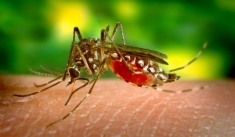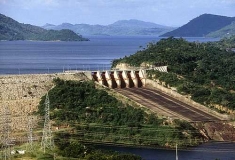More Than One Million Malaria Cases Each Year Due to African Dams, Study Finds

I didn’t feel well during my visit to India’s Narmada Valley, where the Sardar Sarovar Dam was flooding the homes of poor farmers, in 2001. I stayed with affected villagers and joined their protests, but after a while came down with persistent fevers and diarrhea. By the time I reached the closest city, I was so weak and dehydrated that my friends checked me into a hospital. I had contracted malaria, the doctors found.
The connection between dams and malaria has long been known. The stagnant water of reservoirs and the puddles along their shorelines create perfect conditions for the Anopheles mosquito, which transmits malaria, to breed. Yet until now, the problem has never been comprehensively examined. In a new study under the CGIAR Research Program on Water, Land and Ecosystems, Solomon Kibret and four co-researchers closed this gap. Combining databases on dams, malaria and population densities, they systematically analyzed how the incidence of malaria increases around African reservoirs.
The researchers identified 723 dams that are located in Sub-Saharan areas where malaria prevails. Close to 15 million people live within 5 kilometers of their reservoirs – the maximum distance that Anopheles mosquitoes can fly. The researchers found that these people suffer more than 1.1 million additional malaria cases per year due to the reservoirs. In other words, one out of thirteen people in the vicinity of such reservoirs suffers from dam-induced malaria – year for year. The 442,000 people who live near the 60 proposed dam sites in Africa’s malaria regions are expected to suffer an additional 56,000 malaria cases every year if the dams are built.
The researchers acknowledge that the number of 1.1 million cases is certainly an underestimate. They could not find exact data for more than 800 other African dams, most of which are also located in malaria regions. Assuming they have similar impacts, the total number of African malaria cases due to reservoirs could well reach 2 million per year.
I was privileged to have good health insurance when I picked up malaria along the Sardar Sarovar reservoir. For most people in rural Africa, malaria means extended suffering, entrenched poverty and occasionally even death. None of these impacts are addressed in the typical assessments of proposed dams. Likewise, afflicted people have no recourse to compensation for their suffering.
Public health impacts need to be part of the equation when the costs and benefits of dams and other options such as wind and solar projects are compared. Dam operators should be required to set up trust funds from which malaria victims can be compensated. The authors of the new study also recommend that dams be operated in a way that minimizes the breeding grounds of mosquitoes. Finally, public health measures such as the strengthening of local clinics and the distribution of mosquito nets should be part of any dam project that moves forward in a malaria-prone region.
“Whilst recognizing the importance of dams for economic development”, Solomon Kibret and his co-authors conclude, “it is unethical that people living close to them pay the price of that development through increased suffering and, in extreme cases, loss of life due to disease. Those building dams must invest effectively in measures to prevent malaria transmission.”
Peter Bosshard is the Interim Executive Director of International Rivers. He tweets at @PeterBosshard.
Solomon Kibret, Jonathan Lautze, Matthew McCartney, G. Glenn Wilson, Luxon Nhamo. Malaria impact of large dams in sub-Saharan Africa: maps, estimates and predictions. Malaria Journal, 2015; 14 (1) DOI: 10.1186/s12936-015-0873-2



